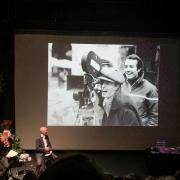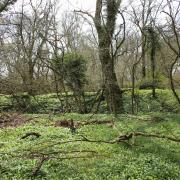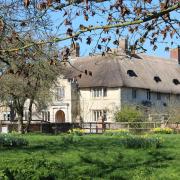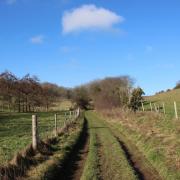Ian McEwan’s Booker Prize-nominated novel On Chesil Beach has been made into a film, but capturing Chesil’s wild windswept beauty proved to be quite a challenge for cast and crew

There are a number of reasons why Ian McEwan’s 2007 novel On Chesil Beach might never have been turned into a film. But you wouldn’t expect James Bond to be one of them.
And yet, eight years ago with a script written by the author himself and Oscar winner Sam Mendes attached to the project, it hit the buffers when the latter was lured away to direct 007’s outing in Skyfall.
So we’ve had to wait until now to see Dorset’s 18-mile long shingle beach on the big screen in all its glory. But the good news is it’s been worth the wait. And the Booker-prize winning author has been involved every step of the way.

“I really didn’t want anyone else to do it,” says McEwan, who has just returned from a walk along the cliffs at Burton Bradstock. “I didn’t want to lose control of the way the story is delivered. I could see a thousand ways of making a very bad movie out of it. It would be all too easy to make it faintly pornographic, exploitative or too comic.”
For the uninitiated, On Chesil Beach tells the back story that leads up to the first few disastrous hours of a young couple’s marriage in the early 1960s. Florence lives in Oxford, Edward near Henley, they’re from very different backgrounds and social classes but they fall in love, marry and briefly honeymoon in a hotel at the western end of the beach. To say much more would ruin the ending. In fact Stephen Woolley, one of its producers, tells me he’s never been involved with a picture that’s so difficult to talk about without spoilers. Suffice to say, in the final act, Chesil Beach itself is the story’s third protagonist.
Now almost 70, Ian McEwan hiked the length of the beach 40 years ago and chose this wild and sometimes bleak Dorset location as the setting for the life-defining showdown between his star-crossed lovers. “The beauty of this coastline is having The Fleet on one side and the sea on the other, so when they walk out onto the beach to have this stormy row that really breaks this marriage apart they’ve got nowhere else to go. Somehow trapped [like this] seemed to me to be the only place in the United Kingdom where I’d want the story to be told. It’s a world treasure, almost planetary in its beauty.”

That it did ultimately end up on the big screen, is down to the tenaciousness of Stephen Woolley’s wife and business partner Elizabeth Karlsen. The creative couple have an impressive record in British cinema, producing films like The Crying Game, Little Voice and Made in Dagenham. But initially it looked like Karlsen had missed out on the film rights to On Chesil Beach before the book was even released. “I first read it as an advance copy sent to me by Ian McEwan’s agent and I was completely floored by the poetic nature of the prose and the poignancy of the emotion - how simple small decisions can have huge impacts on people’s lives. But the rights went to a big studio.” Karlsen watched from afar as the project moved from one studio to another but never got made. “Then one day I bumped into the agent and I said ‘Whatever happened to On Chesil Beach?’ And his reply was ‘Nothing, why? Do you want to do it?’ A year later we started filming.”
The result is a beautiful movie inspired by cinema that came out of Britain in the early 1960s. Its soundtrack features music from Buddy Holly and T-Rex to Rachmaninov and Mozart. The plot, expanded slightly from the book, is by turns romantic, funny and tragic. Saoirse Ronan’s Florence and Billy Howle’s Edward have real on-screen chemistry, and they are joined by a stellar supporting cast of British actors including Anne Marie Duff, Adrian Scarborough, Samuel West and Emily Watson. “That’s one of the great things about working in Britain,” McEwan tells me. “The quality of actors you can get to play relatively minor roles and do it wholeheartedly.”
But the hero of the piece is first-time director Dominic Cooke. The former artistic director of the Royal Court Theatre allows the actors to really flex their muscles, letting scenes play out often without edits. Cooke’s depiction of the beach in the final scene is nothing short of breathtaking, which is all the more impressive when you realise the conditions those shots were achieved in.
If Chesil Beach looks brooding and inhospitable on the screen, it’s because it really was. Cast and crew were there in October 2016, and they had to travel across The Fleet on a flat-bottomed rowing boat which could only carry five people at a time. “Practically it was very challenging,” Karlsen confesses. “It was freezing cold and windy when we filmed on Chesil, and there were no loos out there and no food.
“It was very important to our director and cinematographer that the last scene of the film took place on the promontory so this couple are out there exposed to the elements. They said ‘don’t worry we’re going to do the whole thing handheld.’ Then they decided to use a crane, so we had to take a five tonne crane over piece by piece - rowing through the night - and assemble it on the other side!”
What ends up on the screen looks sublime and can only serve as a calling card for Chesil Beach, just as The French Lieutenant’s Woman did for Lyme Regis, or Broadchurch did for West Bay. However visitors to Chesil Beach will be well-advised not to repeat Ian McEwan’s mistake. At the time of the book’s release he spoke about how he’d taken three or four pebbles from the beach, which is protected as a site of special scientific interest. “I put them back but the press went wild. They said that Dorset County Council was going to fine me £2000. Actually they phoned me and said ‘We’re so grateful to you. We had 60,000 extra visitors this weekend and shops were thriving!’” If that is what a news story about some stolen pebbles can do for Dorset’s tourism, imagine the impact the two glorious hours of this feature film will have!
On Chesil Beach is at cinemas around the UK from mid May.


![Chesil Beach plays a starring role in this feature film alongside Sairose Ronana and Edward Howle [IUSE AS OPENING IMAGE] <i>(Image: Robert Viglasky Photography)</i>](/resources/images/15799957.jpg?type=mds-article-575)
























